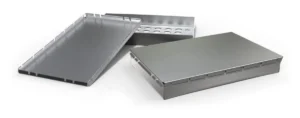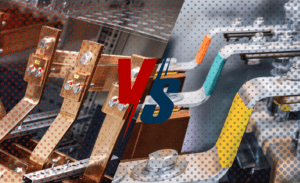Here at Approved Sheet Metal, we know how much the electronics industry relies on high-precision sheet metal parts.
Thanks to our 30+ years of experience, leading electronics companies from around the world trust our team with their sheet metal fabrication needs. But we aren’t just experts in fabricating parts—we also regularly help engineers navigate the design process.
Let’s explore what exactly makes ASM an ideal partner for electronics customers.
Table of Contents
Sheet Metal Fabrication for Electronics
Just about any product that has wires and power cables can benefit from a sheet metal build.
When it comes to fabricating these components and assemblies, ASM has ample experience with the most commonly used materials, such as stainless steel, aluminum 5052-H32, cold rolled steel, galvanized steel, and copper.
From a capabilities standpoint, we’re experts in laser cutting, forming, hardware insertion, welding, and assembly.
This know-how allows our sheet metal shop to fabricate the most sought-after parts in the electronics industry, including:
We also offer a range of finishing, engraving, and silk screening options to make your part really shine.
7 Common Components Used in Electronics Sheet Metal Assemblies
In addition to knowing the basics of sheet metal fabrication for the electronics industry, ASM understands that electronics assemblies can require more hardware than other assemblies, including the following:
- Rivets are permanent fasteners that join two pieces of metal together by deforming the end of the rivet to form a second head. These features provide a strong and vibration-resistant connection for electronics parts.
- Clips and clamps are often used for attaching panels or components to sheet metal enclosures without needing to drill or tap additional holes, allowing for quick assembly and disassembly.
- Latches and catches are used to securely close and lock sheet metal enclosures, ensuring that they remain shut during operation.
- Hinges enable doors and panels to open and close smoothly on sheet metal enclosures.
- Standoffs and spacers create space between components or panels in an enclosure, which facilitates ventilation and simplifies organization.
- Handles may be attached to sheet metal enclosures. These additions can make heavy electronics components and assemblies easier to transport.
- Gaskets and seals create watertight or airtight seals between mating surfaces of sheet metal enclosures, which can prevent moisture or dust from interfering with wiring or circuitry.
Your One-Stop Sheet Metal Shop for Fabrication and Design
At ASM, we have decades of experience fabricating parts for electronics applications and have a solid understanding of the common features, geometry, finish, and material requirements.
This knowledge allows us to help engineers navigate the challenges of precision fabrication to ensure their projects are successful.
Recently, for example, ASM collaborated with Gradient Technologies on a custom sheet metal project. Because their team had minimal experience designing and purchasing sheet metal components, Gradient reached out to ASM for help fabricating and branding both a PCI card and a server-based appliance.
“We were looking for a real partner to work with us,” George Harper, VP Product & Partnerships at Gradient, explained. “We needed more than just a shop that could manufacture these components. We needed [one] that could step up and support us during product development.”
ASM was able to step up to the task by proposing, developing, and finalizing designs before fabricating a small batch of physical prototypes to exacting specifications.
ASM’s Experience and Expertise Support the Electronics Industry
Whether you need a small number of custom parts or are gearing up for a larger production run, we’re here to support you from start to finish.
Need help with your next electronics component or assembly? We hope you’ll give us a shot. Request a quote today!





